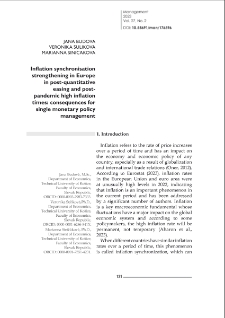Zielonogórska Biblioteka Cyfrowa udostępnia 65 391 obiektów cyfrowych
Obiekt
Tytuł: Inflation synchronisation strengthening in Europe in post-quantitative easing and post-pandemic high inflation times: consequences for single monetary policy management
Współtwórca:
Stankiewicz, Janina - red. nacz. ; Preston, Peter- red. jęz. ; Zmyślony, Roman - red. statyst. ; Skalik, Jan - red. ; Moczulska, Marta - red. ; Adamczyk, Janusz- red.
Tytuł publikacji grupowej:
Abstract:
This paper aims to find out whether the inflation rates of individual European Union (EU) countries are synchronised with those of the EU as a whole and with the euro area (EA). Another objective is to examine the mutual inflation interconnections and its synchronisation across countries. We use the Minimum Spanning Tree (MST) and cross-correlations (C-C). ; Based on structural break tests, the period is divided into four periods: January 2001 - December 2008, January 2009 - March 2015, April 2015 - July 2021, August 2021 - April 2023. The results showed that the direction of the inflation transmission is not the same across the periods under study. Before the financial and economic crisis, Estonian inflation influenced Lithuanian inflation, which in turn influenced the Latvian one; while after the crisis (but just before the application of the ECB`s quantitative easing) Latvian inflation is already influenced by Bulgarian inflation. ; Once quantitative easing had already been applied but in times before the "high inflation" period, the inflation in Lithuania has no impact on the Latvian one. During the "high inflation" period, results conclude the impact of Latvian inflation on the Estonian one. We also point out that inflation rates in some states are not always aligned with average inflation in the EU, the EA. Although, MST results showed that inflation is transmitted mainly from the EA average or the EA countries, having a more central position (e.g. Slovakia has generally a more central position than the Czech Republic, Hungary, or Poland). ; Therefore, countries having common monetary policy are more resistant to external inflation shocks and rather influence the inflation of other countries. Finally, even if inflation rates are synchronised, inflation may be outpaced or lagged by one to several months, which may present policymakers with the question of the appropriate monetary policy stance.
Wydawca:
Zielona Góra: Faculty of Economics and Management Press
Format:
Identyfikator zasobu:
DOI:
Strony:
Źródło:
Management, vol. 27, no 2 (2023)
Jezyk:
Prawa do dysponowania publikacją:
Biblioteka Uniwersytetu Zielonogórskiego
Kolekcje, do których przypisany jest obiekt:
- Zielonogórska Biblioteka Cyfrowa > Repozytorium > Jednostki organizacyjne > Wydział Ekonomii i Zarządzania
- Zielonogórska Biblioteka Cyfrowa > Repozytorium > Typy utworów > Artykuły
- Zielonogórska Biblioteka Cyfrowa > Repozytorium > Czasopisma naukowe i serie wydawnicze UZ > Management
- Zielonogórska Biblioteka Cyfrowa > Repozytorium > Czasopisma naukowe i serie wydawnicze UZ > Management > Management, volumen 27 (2023)
Data ostatniej modyfikacji:
31 mar 2025
Data dodania obiektu:
7 lut 2024
Liczba wyświetleń treści obiektu:
239
Wszystkie dostępne wersje tego obiektu:
https://zbc.uz.zgora.pl/publication/87097
Wyświetl opis w formacie RDF:
Wyświetl opis w formacie OAI-PMH:
Obiekty Podobne
Brixová, Barbara Šuliková, Veronika Siničáková, Marianna Wyrwa, Joanna Stankiewicz, Janina - red. nacz. Preston, Peter- red. jęz. Zmyślony, Roman - red. statyst. Skalik, Jan - red. Moczulska, Marta - red. Adamczyk, Janusz- red.
Jędrzejczak-Gas, Janina Barska, Anetta Siničakova, Marianna Moczulska, Marta - red. Preston, Peter- red. jęz. Stankiewicz, Janina - red. nacz. Zmyślony, Roman - red. statyst. Adamczyk, Janusz- red. Skalik, Jan - red.
Dzikuć, Maciej Dzikuć, Maria Siničakova, Marianna Skalik, Jan - red. Adamczyk, Janusz- red. Moczulska, Marta - red. Preston, Peter- red. jęz. Stankiewicz, Janina - red. nacz. Zmyślony, Roman - red. statyst.

